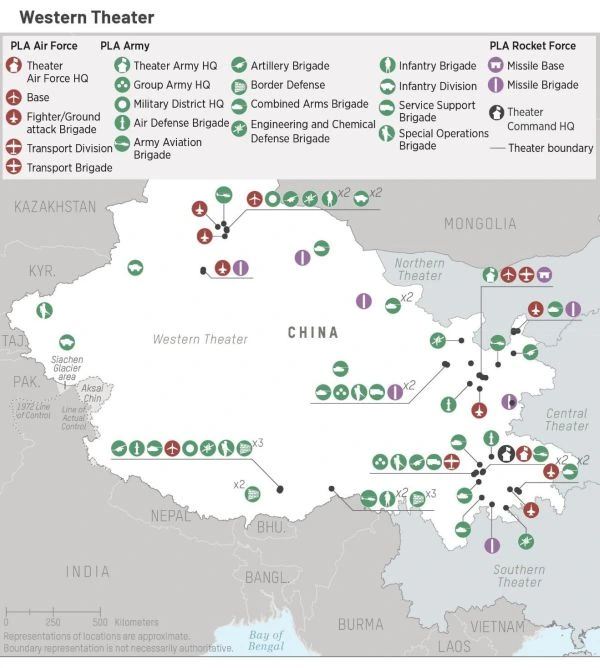The Western Theater Command is oriented toward India and counterterrorism missions along China’s Central Asia borders.
The Western Theater Command is geographically the largest theater command within the PRC and is responsible for responding to conflict with India and terrorist threats in western China. PLA units located within the Western Theater Command include 76th and 77th Group Armies and ground forces subordinate to Xinjiang and Xizang Military Districts; three PLAAF bases, one transportation division, and one flying academy; and one PLARF base. PAP units responsible for internal security operations are also likely under the control of the Western Theater Command.
Within China, the Western Theater Command focuses on Xinjiang and Tibet Autonomous Regions, where the CCP perceives a high threat of separatism and terrorism, particularly among Uyghur populations in Xinjiang. According to the U.S. Department of State’s 2021 Country Reports on Human Rights Practices, in the PRC, “genocide and crimes against humanity occurred during the year against the predominantly Muslim Uyghurs and other ethnic and religious minority groups in Xinjiang.” Authorities were reported to have arbitrarily detained more than one million Uyghurs, ethnic Kazakhs, Kyrgyz, and other Muslims in extrajudicial internment camps designed to erase religious and ethnic identities. PRC government officials justified the camps under the pretense of “combatting terrorism, separatism, and extremism,” however, greater criticism from the international community, including the United Nations, refute such justifications. Moreover, ethnic oppression of Muslim Uyghurs and other ethnic and religious minority groups in Xinjiang is likely used by extremist organizations as a propaganda and recruiting tool, generating new threats to the region.
Since early May 2020, sustained tensions along the India-China border dominated the Western Theater Command’s attention. Differing perceptions of border demarcations along the Line of Actual Control (LAC) combined with recent infrastructure construction, led to multiple unarmed clashes, an ongoing standoff, and military buildups on both sides of the India-China border. In response to a skirmish in June 2020 between PRC and Indian patrols in Galwan Valley – the most violent clash between the two countries in 45 years-the Western Theater Command conducted a large-scale mobilization and deployment of PLA forces along the LAC. Negotiations stalled throughout 2021, with the 13th round of military commander negotiations breaking down in October . Due to the sustained military development along the LAC, the Western Theater Command’s deployment will likely continue through 2022.
China-India Border
Throughout 2021, the PLA sustained the deployment of forces and continued infrastructure build up along the LAC. Negotiations made minimal progress as both sides resist losing perceived advantages on the border.
Beginning in May 2020, PRC and Indian forces faced off in clashes with rocks, batons, and clubs wrapped in barbed wire at multiple locations along the LAC. The resulting standoff triggered the buildup of forces on both sides of the disputed border. Each country demanded the withdrawal of the other’s forces and a return to pre-standoff conditions, but neither China nor India agreed on those conditions. The PRC blamed the standoff on Indian infrastructure construction, which it perceived as encroaching on PRC territory, while India accused China of launching aggressive incursions into India’s territory. Since the 2020 clash, the PLA has maintained continuous force presence and continued infrastructure build up along the LAC.
The 2020 Galwan Valley incident was the deadliest clash between the two nations in the past 46 years. On June 15th, 2020, patrols violently clashed in Galwan Valley resulting in approximately twenty Indian soldiers and the death of four PLA soldiers, according to PRC officials.
Throughout the standoff, PRC officials sought to downplay the severity of the crisis, emphasizing Beijing’s intent to preserve border stability and prevent the standoff from harming other areas of its bilateral relationship with India. The PRC seeks to prevent border tensions from causing India to partner more closely with the United States. PRC officials have warned U.S. officials to not interfere with the PRC’s relationship with India.
=========================
Western Theater Command Leadership (2021)
Commander of the Western Theater Command – General Zhang Xudong.
Current position: Commander of the Western Theater Command Previous position: Commander of the Central Theater Command Army DOB: 11/1962
Age: 59
Political Commissar of the Western Theater Command – General Wu Shezhou.
Current position: Political Commissar of the Western Theater Command Previous position: Political Commissar of the Central Theater Command Army and Deputy Political Commissar of the Central Theater Command DOB: 1958, Age: 63
Chief of Staff of the Western Theater Command – Lieutenant General Rong Guiqing
Current position: Chief of Staff of the Western Theater Command Previous position: Chief of Staff of the Chengdu Military Region DOB: 5/1958. Age: 63
Birthplace: Weishi County, Henan Province
Education: Graduated with a master’s degree from the Department of Joint Campaign Command of the PLA National Defense University

















